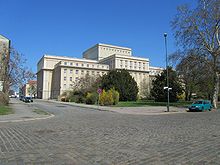Anhalt theater
The Anhaltisches Theater Dessau is a multi-discipline theater with drama , music theater (opera, operetta, musical), ballet , concert ( Anhalt Philharmonic ) and puppet theater .
Today the theater has a capacity of around 1100 spectators and is equipped with one of the largest revolving stages in Germany. In October 2013, the multi-branch theater was included in the Red List of Culture of the German Cultural Council and classified in Category 2 as endangered .
history
Theater life in Dessau looks back on a long tradition. There was a permanent theater company in Dessau as early as 1794 . The first venue was the Princely Reitbahn, the first theater director Friedrich Wilhelm Bossann . The Anhalt Philharmonic was also founded at this time .
By 1798, Friedrich Wilhelm von Erdmannsdorff ( Wörlitzer Park ) built the first theater building. As Duke Leopold III. Friedrich Franz closed the theater in 1810 for financial reasons as a result of the war, the Societätstheater enthusiast project once again gained in importance for a short time.
After two fires in 1855 (rebuilt) and 1922, the Fürstliche Reitbahn was again the venue.
After three years of construction, the current building was completed in 1938 as the largest stage north of the Alps at the time with 1250 seats. Architects were Friedrich Lipp and Werry Roth . The opening took place on May 29, 1938 in the presence of Adolf Hitler and Joseph Goebbels . The opera Der Freischütz was given .
After the almost complete destruction in one of the heavy air raids on Dessau on May 30, 1944, the theater was reopened in 1949 after reconstruction with Mozart's Die Zauberflöte under the direction of Willy Bodenstein (director from 1949 to 1968). In the period from 1945 onwards, the remaining theater people found a provisional rehearsal and performance room and rehearsals began again in November 1945. A first performance of Beethoven's Fidelio took place in December . Willy Bodenstein followed as artistic director or general director:
- 1968–1973: Karl Schneider
- 1973–1983: Herbert Keller
- 1983–1992: Peter Gogler
- 1992–2009: Johannes Felsenstein
- 2009–2015: André Bücker
In 1994 the house, previously known as the State Theater in Dessau, was named the Anhaltisches Theater.
Due to massive cuts in the state subsidy by the state government of Saxony-Anhalt in 2013, the theater saw its continued existence as endangered. Even by closing three lines of business, the savings targets cannot be met. General manager Bücker was a sharp critic of the cuts. His contract was not extended beyond the 2014/2015 season by the city of Dessau.
Johannes Weigand has been General Director of the Anhaltisches Theater since the 2015/2016 season . Weigand was the opera director of the Wuppertaler Bühnen until 2014 .
Awards
In 1954 the theater was awarded the Silver Patriotic Order of Merit .
literature
- Hartmut Runge: Dessau theater pictures. On the 200-year history of the theater in Dessau . Anhaltische Verlagsgesellschaft, Dessau 1994, ISBN 3-910192-27-0 .
- Karl-Heinz Köhler, Lutz Buchmann, Ronald Müller: From the Princely Court Chapel to the Anhalt Philharmonic - 250 Years of the Orchestra in Dessau, ed. from Anhaltisches Theater Dessau, Jonitzer Verlag, Dessau 2016, ISBN 978-3-945927-05-2
Web links
- Anhalt theater
- Book publication, authors, photo series - publication: From the Princely Court Chapel to the Anhalt Philharmonic - 250 Years of the Orchestra in Dessau
Individual evidence
- ↑ Land wants to cut three million euros , Mitteldeutsche Zeitung, June 12, 2013.
- ↑ Mitteldeutsche Zeitung of July 23, 2014: Anhaltisches Theater in Dessau: Critics of the austerity course Bücker should go , by Heidi Thiemann and Kai Gauselmann , accessed on July 26, 2014
- ^ New Germany, October 7, 1954
Coordinates: 51 ° 50 ′ 12 ″ N , 12 ° 14 ′ 11 ″ E



